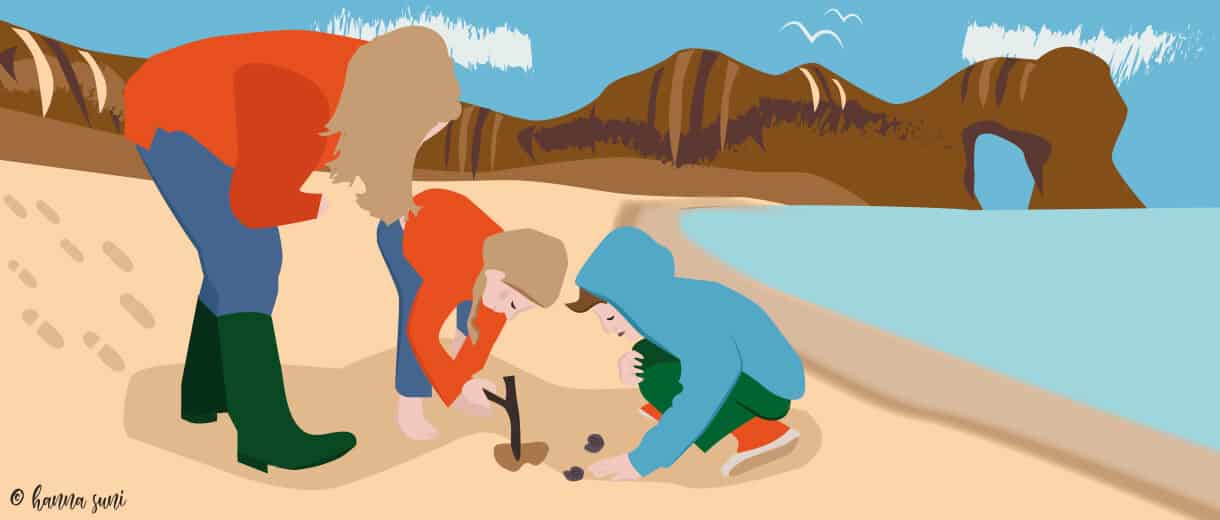East Devon Coast: A Jurassic Family Journey To Remember
With its scenic clifftop coastal walks and sweeping views across the sea and countryside, East Devon’s Jurassic coast is a recognised area of Outstanding Natural Beauty and a gorgeous place for a post-lockdown escape. It has some of the most beautiful beaches in the region, most of which are found in quaint towns and villages, where a variety of local produce, as well as high street shops and restaurants, can be found, along with traditional pubs and some of the best hotels in the South West.
Here are a handful of lovely things to do and see with (or without) children.
The 8 Wonders of the East Devon Coast
- Budleigh Beach and the Otterton Estuary walk
Budleigh Salterton’s distinctive red cliffs cannot fail to impress with their unique beauty. The red earth provides a stunning contrast to the surrounding emerald green meadows and if you’re the walking type, you can dip in and out of the coastal path at any time. The beach here is pebbly (they are smooth and round and affectionally known as ‘Budleigh buns’. The locals are very proud and possessive of them. Collecting pebbles is really frowned upon, so be warned!). Unlike many of Devon’s other beaches, there are no water sports, therefore it remains a quiet family-friendly beach with only the local fishing boats bringing in their daily catch. Get down to the beach early if you want to buy fresh crab.
Some of Budleigh’s elderly residents swim in the sea come rain or shine, all year round. The Christmas Day morning swim is quite a sight to behold. They are a hardy bunch indeed!
Dogs are also welcome most of the year except during the summer months when there is a designated area for them. There is a shack at one end where you can get cups of tea and delicious fresh crab sandwiches and ice-creams. The pleasant promenade along the seafront has quite a choice of eateries.
The town has a cosy feel to it and some lovely independent shops along the main drag with tea rooms selling sumptuous home-made cakes. There are also several art galleries and the Fairlynch Museum is one of only a handful of thatched museums in the UK. It makes for an interesting visit with a gorgeous garden and period costumes as well as geological and archaeological collections including a smuggler’s den.
Budleigh’s annual literary festival in September is renowned and it’s worth noting that the Honorary President is a local resident and veritable Crunchy Lady, Dame Hilary Mantel herself (author of ‘Wolf Hall and Bring up the Bodies’).
Budleigh’s Otter estuary at the far end of the beach is a bird-watchers paradise all year round with hides on either side. You may see egrets and ibis, wagtails, herons, buzzards flying overhead and if you’re really lucky, kingfishers too.
The walk along the estuary from Budleigh towards Otterton is just under 3 miles so don’t forget your camera and binoculars. You’ll be rewarded at Otterton as the mill is just at the end of the walk and has a lovely café for Devonshire teas and other delights. The mill is still operational and has been there in one form or another for a thousand years. There are tours when it’s running. The arts and crafts shop offers an assortment of beautiful locally made jewellery and other items and a perfect place to while away an afternoon.
- Sidmouth beach
Sidmouth is more bustling with water sport activities, narrow streets and independent shops. Its selection of historic buildings alongside more modern additions makes for an interesting visit. Enjoy wandering around the old town and dip into the jewellery shops tucked away down the side lanes and little courtyards. The traditional beach esplanade has the usual ice-creams and deck chairs and there is an array of cafes and restaurants to choose from. You can kayak and paddleboard too and it can get busy as it’s very popular.
There are a few buildings worth checking out from an architectural perspective and which date from the early 20th century. The little known RW Sampson (1866-1950) designed them as well as the Victoria Hotel.
Interestingly, there is an observatory on Salcombe Hill called the Norman Lockyer Observatory and it’s a great little place to bring the children. There are several telescopes including a donated Newtonian telescope plus a lecture theatre and planetarium. Check before you go as it’s only open to the public twice a month but there are a number of interesting events to attend including a meteor watch, a spring moon watch and some open afternoons when you can have a mooch around and find out more about the history of the place. Outside there is a particular spot where if you position your feet correctly, the sun will cast your shadow onto the correct time!
- Colyton
This medieval village has an impressive church with enormous stained glass windows which was quite surprising given the size of the village. Colyton is located on the River Coly and there are some beautiful walks through the valley and along the river. The old cottages are simply gorgeous and you can feel history emanating from every stone. The Romans apparently settled close by and built a road which linked it to Exeter, Sidmouth and Lyme Regis. Wealthy families settled it too, and by the 15th century, Colyton became rich on wool. Some of the original houses date from 16th and 17th centuries and line the narrow lanes. There is a functioning tannery which a local described as ‘Dickensian’.
- Seaton, Beer and Branscombe
Seaton isn’t the most picturesque of the seaside towns, but the beach is very pleasant. You can park here and walk a couple of miles to the lovely town Beer. The clifftop walk is steep and long, but you can also go along the beach at Seaton and join the path at the Hideaway café right at the far end. You’ll still need to climb up before descending into Beer. It is a lovely walk and the views are reminiscent of the south of France in the summertime.
The name has nothing to do with the drink beer, incidentally, and it’s a very quaint fishing village, flags and bunting adorning the buildings like your archetypal English country village. The name comes from an old English word bearu which means peninsula or grove. The buildings here are made from the local limestone which has been used to build cathedrals across Britain. The jetty and beach area just down from the main street have information about marine life and there are many events and tours available including walks, rock-pooling, history and geology, fossils and many more. In fact, the Romans appreciated the quality of Beer rock and it’s been used ever since. The mine closed in 1920. You can spend a gorgeous beachy day here swimming, enjoying burgers and prawn sarnies for lunch on the beach.
Branscombe isn’t a village at all but has a series of picturesque cottages snuggling into a combe. The beach is an impressive mile-long curve between steep hills with a pub at each end and a number of National Trust properties. Its prettiness attracts many visitors to the area.
Do a lovely walk starting at the Donkey sanctuary where you can choose innumerable paths down to the coast varying in steepness. The scenery is varied and you’ll cross some woodland before accessing some gorgeous sections of the coastal path.
- Lyme Regis
Nip across the border to Dorset and visit lovely Lyme Regis with its narrow snaking streets and pretty seafront. The manmade harbour ensures the sea remains protected which makes it ideal for kayaking or paddleboarding. The little town is a gem and best explored on foot where you’ll discover hidden streets replete with independent shops and eateries. You’ll see plenty of places selling fossils and inside St Michael’s Church up the hill on the main street, there is a stained-glass window commemorating the fossil hunter, Mary Anning (1799-1847) another veritable Crunchy Lady who was way ahead of her time. Her grave has become a mecca for palaeontologists and geologists. Her work challenged the religious thinking of her day, providing the key to a shift in scientific thought about the history of the earth. Her father taught her how to find and clean the fossils hidden within Lyme Regis’ cliffs when she was a small child. They sold them to the wealthy tourists who visited the town in the summer. She taught herself geology and anatomy and made some important discoveries. As a woman, she wasn’t allowed to join the Geological Society of London and so like so many women of her time, she received barely any recognition for her work.
Tips for fossil hunting
It is always worth doing your homework before you set out on your fossil adventure. Different beaches have different age rocks and fossils and you can expect to find different things. If it is your first-time fossil hunting it is always a good idea to join an organised guided walk.
- Go after stormy or rough seas as the frequent cliff falls mean the shingle is turned over exposing new fossils.
- Keep away from the cliffs when you’re hunting as landslides are quite common
- Consider wearing sturdy boots or shoes as the rocks can get slippery with seaweed.
- Most importantly, don’t get caught out by the tides as you can easily get stranded when you’re concentrating on hunting for fossils.
- If you find something you think could be interesting ask a local expert but you may need to register it as scientists have the right to study fossils for a number of months following registration.
Where To Eat
Eat, relax and shop organically here in a relaxed historic atmosphere listening to the peaceful sounds of the water through the mill. There is a bakery, a cafe, a craft shop all in the midst of a gorgeous setting just a stone’s throw from the estuary that links Otterton to Budleigh Salterton. It’s a lovely walk between the two.
Overlooking the Exe Estuary, it is the perfect place to enjoy fresh seafood. You can enjoy freshly caught local fish landed that day, from sole, bream, mackerel, monkfish and pollack amongst other fish species on our local fish menu.
It is just up from the beach at Budleigh Salterton. Delicious local fish available as well as Devon cream teas and full English breakfasts. The extensive wine list includes many local Devon wines and ciders. Don’t forget to finish up with a fresh mango sorbet.
Where to stay
Near Colyton, it is a beautiful architecturally designed modern house made from cedar wood and glass. It has a sizeable garden and is surrounded by Devon emerald-green countryside. There are many walks you can do from here and the family is onsite and very helpful. They gave you free rein of their veggie plot which kept you healthy and happy.
It is a charming, characterful property converted from the original 18th Century dairy, which has undergone extensive and tasteful refurbishment. Situated on both the South West Coast Path and Exe Estuary Trail (an ideal location for cyclists and walkers alike), it offers three well-appointed rooms, one of which is situated on the ground floor, together with a self-catering holiday cottage, sleeping up to four guests.
With glorious sweeping views of Lyme Bay, The Victoria Hotel is one of England’s finest hotels. A magnificent luxury hotel perfectly situated for exploring the timeless charms of Sidmouth, a picturesque Regency town. Many of the fabulous rooms have breathtaking views over Lyme Bay and there are wonderful facilities for you to enjoy including a Spa, heated indoor pool and outdoor pool in the summer.





